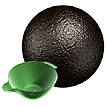
HDPE is lighter than water, and can be moulded, machined, and joined together using welding (difficult to glue).
The appearance is wax-like, lustreless and opaque. The use of UV-stabilizators (carbon black) improves its weather resistance but turns it black. Some types can be used in contact with food.
Danish Name
Category
Products
Bottle for motor oil
Bottle for organic solvents
Street bollard
Hedge cutter
Gasoline tank
Milk bottles
Plastic bag (stiff type that crackles)
Children's toys
Lid for honey pot
Beer crate
Dolphin bicycle trailer
Processes
Plastic injection moulding
Extrusion
Film blowing
Blow moulding
Similar materials
and many other plastics
Price
Environmen- tal notes
Use: -
Disposal: Used PE plastic can be recycled through remelting although there is a quality loss. Incineration is straightforward and comparable to oil, since PE only consists of hydrogen and carbon atoms.
In an incineration plant only water and carbon dioxide are produced. However common additives like UV-stabilizators (e.g. carbon black), dyeing agents and fire protectors can produce other waste products. Heating value is equivalent to 3/4 kg of oil.
Additional Info
Photo
Copyright
This page is part of Design inSite
Disclaimer